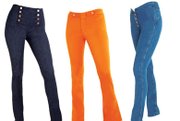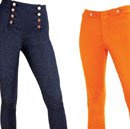New Denim Collection Blends Chemin de Fer Heritage and Rock & Republic Experience
With its hip-hugging looks and its sailor-pants flap, Chemin de Fer wasone of the iconic denim brands of the 1970s. A relaunch is in the works by the son of the original founder with help from Rock & Republic veteran Andrea Bernholtz.
Jason Gaon, the son of Chemin de Fer founder David Gaon, is quick to point out that his new effort is no exercise innostalgia. He and his team will introduce a new line, called De Chemin,that will mix the DNA and sizzle of the original Chemin de Fer with the style of premium denim.
As De Chemin competes for attention with the scores of jeans brands introduced each year, Bernholtz, a consultant to the brand, said De Chemin will have an edge, with its nod to past styles.
“It has a heritage,” Bernholtz said. “It’s not just another cool brand; it came from somewhere. Not a lot of people can say that.”
Bernholtz is a partner with Los Angeles–based brand-consulting company Brand-Aid Inc., and until last year, she was president of jet-setting premium-jeans brand Rock & Republic. The line’s trademarks were sold to VF Corp. in2011, and the line was licensed to Kohl’sCorp. to make a popular-priced version of the jeans.
Discussions to start the De Chemin venture began in March. First, samples were delivered to the Los Angeles–based Liza Stewart Showroom in early August. The collection debuted at the recent Los AngelesFashion Market. It also will be shown at the CALA trade show, scheduled to run Aug. 27–28 in San Francisco.
To make a splash, Bernholtz and Gaon agreed the heritage line needed a rebranding. De Chemin kept the most iconic looks of the brand but cut out most 1970s styles of the old brand.
Some classic details remain, including the sailor’s flap in the front of the pant and the buckle in the back. The 13-inch rise is gone. Instead, the pants feature 8- and 8.5-inch rises. Flared legs? Out. They were replaced with contemporary bodies, such as the perennially popular skinny jeans.
Also gone is the heavy denim fabric. De Chemin features a host of fashion fabrics, including herringbone, plaids, stretch denim and stretch cotton twill. The pant also has a back yoke that lifts and shapes the behind to make it look more curvy.
Wholesale prices points range from under $100 for denims and twill pants to $120 for bottoms made out of fashion fabric. Bernholtz said De Chemin will sell to boutiques and, eventually, to retailers globally. De Chemin will focus on bottoms rather than becoming a lifestyle brand, Bernholtz said.
The Liza Stewart Showroom specializes in contemporary fashion, and owner Liza Stewart agreed to represent the brand because it blended old and new.
“Pants are trending now,” Stewart said. “Their styling has a lot of newness.”
Chemin de Fer founder David Gaon passed away in 2003 after a career in fashion. But Jason Gaon made it a point tofollow his own path by selling cars and running auto dealerships, as well as entrepreneurial ventures in transportation, warehousing and marketing.
One reason why he jumped into his dad’s game was generational competition. “I think I could do it better,” Gaon said. “My dad told me that the sky is the limit and ‘if you could do something better than me, do it.’”
To get the fashion project started, the younger Gaon reached out to some of his dad’s friends, including Fred Gaylord, a factor with Bibby Financial Services. Gaylord recommended Bernholtz, and the ball quickly got rolling. Gaon said he did not attempt to buy the trademarked Chemin de Fer name. A trademark search found the last trademark holder is Pacific Knitting Mills Inc. Gaon said there is enough space between his line and Chemin de Fer to pass any trademark test. “It’s not the same line,” he said. “It’s not the same product.”
Denim and fashion-industry experts said De Chemin will benefit from nostalgia and brand equity, but any honeymoon will be short-lived, said Adriano Goldschmied, the denim veteran who designed Diesel, Replay and his own AdrianoGoldschmied brand. He currently serves as the creative director for Citizens of Humanity’s men’s line and is the founder and creative director for the brand Goldsign, both headquartered in the Los Angeles area.
“I’ve been in discussions many times with bringing back brands,” Goldschmied said.
“Sometimes, people think that if you acquire a brand that has strong history, that is enough for success. But it is like sport;every game is a different game. For sure, you get some attention. But the reality is the final consumer … just consider[s] that the product looks like it has the right fabric and the right wash.”
Like Goldschmied, Mark Werts, founder of American Rag and Industrie Denim boutique store chains, has a decadeslong history in jeans sales. For Werts, any brand relaunch has a possibility for fantastic success. “The only thing that matters is the execution. It’s that simple,” Werts said. “The ones that are passionate and are properly capitalized will be successful.”
However, the laws of success are rough for anybody. For every successful brand relaunch, such as Penguin and Lanvin, there are scores that do not make it, said Doug Lipstone, partner in the Santa Monica office of law firm Enenstein & Ribakoff, where he specializes in trademarks and copyrights. But anyenterprise with brand equity will get a head start. “Like movies, it is easier to make a sequel than an original movie,” Lipstone said. “Namerecognition can be so powerful.”























